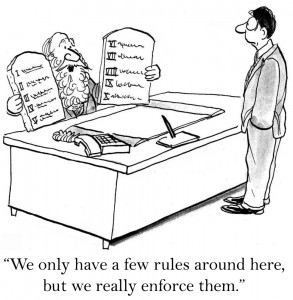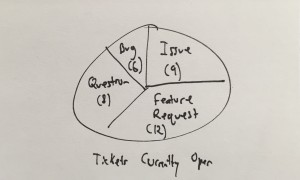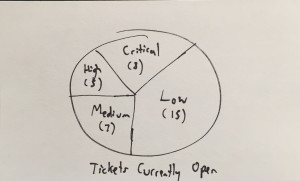“What gets measured, gets managed” –Peter Drucker (father of modern management)
“Ok…but what the hell am I supposed to measure?” -Everyone else

The million-dollar question: “What should I be measuring?” A customer service department has endless possibilities of data points to track and use as Key Performance Indicators (KPIs). Every service ticket is (hopefully) logged in a support-ticketing system like ZenDesk or SalesForce – but that just adds to the confusion. As someone who’s gone through this problem firsthand, I’ve written this post to remove the cloud of confusion around customer service metrics by giving you guiding principles for establishing an effective KPI program and specific KPIs to use.
9 Guiding Principles

- KPIs will never replace talking to your customers. You can only fix the problems you know about and not everything is logged as a support ticket. If a customer raises an issue and your data shows otherwise, you can review the data together to find the disconnect. Conversely, you may find that customers think everything is OK while their KPIs suggest otherwise. These discussions are all part of relationship building and shouldn’t be thought of as a “got ya.” Instead, use the conversation as a way to build on your relationship and flesh out any problems with your processes.
- You won’t get it right the first time. You will never be “done.” Don’t let perfect get in the way of good. When initially developing and building KPIs, fight the urge for perfection and release a KPI once it’s 80% complete.
- Set thresholds for what’s good, average, and not so good. Also known as RAG (red, amber, and green) ratings, these help determine what is working well and what needs attention. Your company’s executive team will also rely on these ratings when quickly assessing the health of the organization.
- 100% team alignment. Everyone on your team must know what’s being measured and how it aligns with department goals. This means everyone should be knowledgeable of every KPI and why it matters (yes, this means having a formal discussion with your team). When the “why” is established, KPI adoption will skyrocket.
- Full transparency. The KPIs you’re measuring must be fully visible to everyone on the team and the entire company (gasp!). Your first reaction may be, “Why should Sally be able to see how John is performing? Isn’t that a bit much?” Think of sharing KPIs across the team as a form of open communication that removes barriers. Exposing KPIs to the entire company will hold you accountable for your performance and also cut down on the number of “how’s it going?” questions.
- Consistently track every KPI across every level of your team. If you are tracking X KPI (e.g. volume of tickets per month) at the department level, make sure you’re also measuring X for each individual contributor. This allows everyone on the customer service team to see how her performance is contributing to overall team objectives. Think of the alternative scenario: measuring X for the department but measuring Y for each individual. This is a problem because everyone will be trying their hardest to improve Y, while having little or no impact on X.
- Review metrics regularly. KPIs are only useful if you look at them! Decide how often each KPI needs to be reviewed, then make that information public knowledge. Set a recurring calendar reminder to review the metrics as part of your day-to-day activity—you’ll be able to use the data to improve performance.
- Publish results & corrective actions. Your team will want to see how everyone is doing and what has changed based on KPI performance. Consider creating a monthly report that reviews the prior month’s metrics and what actions have been taken. Once you have a template for this analysis, it will take you 15 minutes to compile and internally distribute monthly reports. When things are going well, the report shows the company that your team is kicking ass. When things aren’t going well, it gives you a chance to proactively share what corrective actions are in place.
- Real-time data & monthly trending. There are two key groupings of metrics you’ll need to track:
- Real-time data capture data as it stands now and allow for course correction. These KPIs keep things humming on a day-to-day basis: What does my volume look like right now? How many high-priority tickets are currently open? Does Team A have too much work? Does Samantha have too many tickets in her queue? The real-time KPIs are always a reflection of the current state of the team and should capture data that can be actioned immediately.
- Historical trending captures and trends performance over several prior periods (e.g. months, quarters): How many tickets do we handle each month? Did we meet our contractual requirements last month? What is the trending of ticket age over the past X months? It’s normal to have KPIs that are important enough to review in real time and as a historical trend.
Specific Customer Service KPIs You Need to Know (and Should Use)

Every customer service KPI boils down to two key categories: Quantity (how many, how often) and Quality (how good).
Quantity
Of the two key areas, Quantity is the easier concept. Quantity in support is typically measured in the number of tickets worked in a certain unit of time.
Tickets Opened – This is the baseline quantity KPI, which measures how many tickets are opened each month. Set RAG thresholds to determine when you’re in the danger zone. If you have the data, it’s worthwhile to review historical trendsto determine spikes due to seasonality (and plan accordingly).
Tickets by Customer (or Customer Segment) – If you have less than 100 customers, you should track by customer. When you reach 100 customers, create segments based on common attributes.
Ticket by Root Cause – It’s important to have a field that captures root cause on every ticket. This will let you dig deeper and ask, “How can we eliminate this type of ticket from ever coming up again?” It’s also a great KPI to review with your VP of Product Management. I also recommend trending this over time.
Tickets by Severity – It’s extremely important to capture this data in real time to allow your teams to jump on the highest severity tickets. It’s also valuable to have each employee review them before they leave for the day to ensure high and critical cases are handed off. I also recommend trending this over time.
Tickets by Product Management Category – The purpose of this KPI is to identify product problem areas. I recommend grouping tickets according to the way your Product Management team (PM) is structured. If every PM owns a particular module, track tickets by module. If every PM owns a specific integration, track by integration area. I also recommend trending this over time.
Quality
Quality is more difficult to measure than quantity. Why? Because you have to think about what quality and the definition of success mean to YOUR company. Most high-quality KPIs also require configuration in your ticketing system because they’re not captured out of the box. I’ve found the below high-quality KPIs to have the most bang for their buck:
Age of Resolved Tickets – Measure the time it takes to resolve a ticket after it’s been opened. Track this over time and set red, amber, or green (RAG) ratings to define success.
SLA Performance – Create a KPI for every contractual SLA you have with your customers (e.g. initial response time, resolution time). If you don’t have any contractual SLA’s (lucky you!), create service levels that you want your team to follow and track. I like to track these by calculating the percentage of tickets that meet their SLA, because it levels the playing field in cases where different SLAs exist.
Support Quality Survey Results – The above KPIs are a good indicator of quality but may not always capture the full sentiments of your customers. Again, talk (and listen) to your customers. Ask them a simple question after every ticket is closed—”How do you rate the quality of support for this ticket?”—and give them choices between 1 (poor) and 5 (excellent). I like this approach for a few reasons:
- It amplifies the customer voice, which may clarify KPIs like ticket age and SLA performance.
- Each survey result corresponds to a single support ticket, which gives feedback on an individual performer. This data can also be rolled up at the support-team or customer level for trend analysis.
- It gives you the chance to follow up with a customer when ratings are subpar. I recommend calling or emailing every customer who gives a 1 or 2 rating. This will give you the opportunity to dig deeper into the root cause of the problem and find ways to improve.
Closing Thoughts
Don’t worry about getting KPIs perfect the first time around. Pick a few, implement them, see how they’re working, and iterate. Think about how you want to measure quantity and quality. Make sure you communicate what you’re measuring and why to your team. Follow these basic guidelines and you’ll be better off than 90% of other customer service managers.
What KPIs have you found useful in your business?









